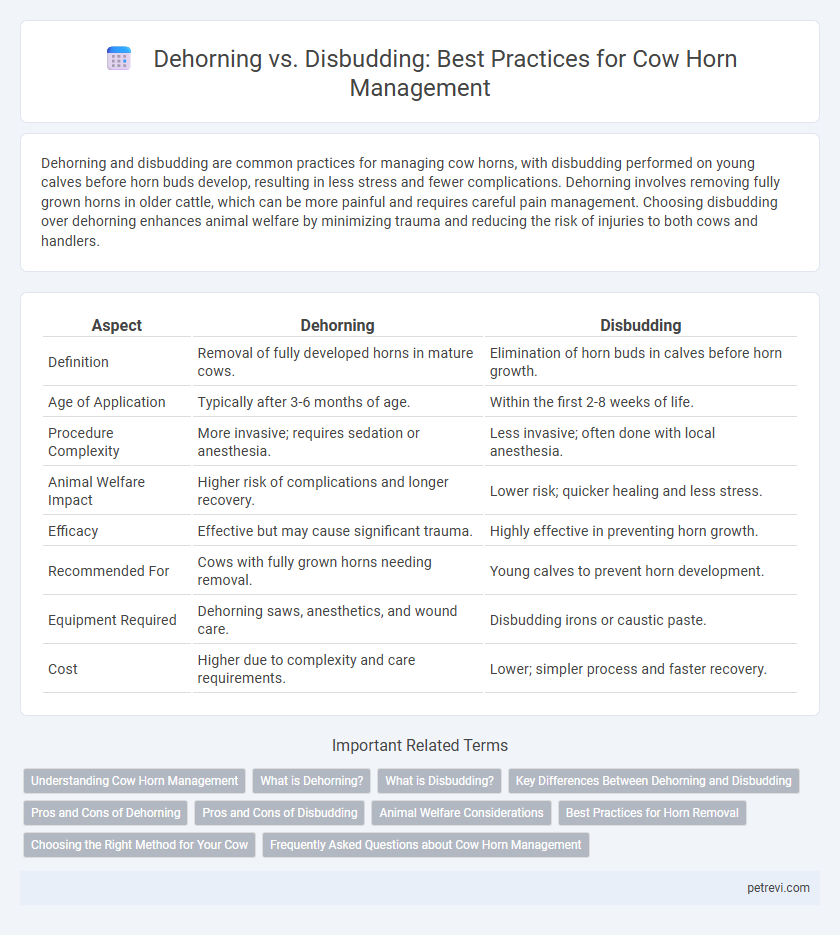Dehorning and disbudding are common practices for managing cow horns, with disbudding performed on young calves before horn buds develop, resulting in less stress and fewer complications. Dehorning involves removing fully grown horns in older cattle, which can be more painful and requires careful pain management. Choosing disbudding over dehorning enhances animal welfare by minimizing trauma and reducing the risk of injuries to both cows and handlers.
Table of Comparison
| Aspect | Dehorning | Disbudding |
|---|---|---|
| Definition | Removal of fully developed horns in mature cows. | Elimination of horn buds in calves before horn growth. |
| Age of Application | Typically after 3-6 months of age. | Within the first 2-8 weeks of life. |
| Procedure Complexity | More invasive; requires sedation or anesthesia. | Less invasive; often done with local anesthesia. |
| Animal Welfare Impact | Higher risk of complications and longer recovery. | Lower risk; quicker healing and less stress. |
| Efficacy | Effective but may cause significant trauma. | Highly effective in preventing horn growth. |
| Recommended For | Cows with fully grown horns needing removal. | Young calves to prevent horn development. |
| Equipment Required | Dehorning saws, anesthetics, and wound care. | Disbudding irons or caustic paste. |
| Cost | Higher due to complexity and care requirements. | Lower; simpler process and faster recovery. |
Understanding Cow Horn Management
Dehorning and disbudding are two primary methods of cow horn management, each with distinct timing and techniques to ensure animal welfare and safety. Disbudding is performed on young calves, typically within the first few weeks of life, to prevent horn growth by destroying the horn-producing cells, while dehorning involves removing developed horns in older cattle using physical or chemical methods. Effective cow horn management reduces the risk of injuries to other animals and handlers, minimizes stress, and is essential for maintaining herd health and productivity.
What is Dehorning?
Dehorning is a horn management procedure involving the complete removal of a cow's mature horns, typically performed on older animals with fully developed horn tissue. This process is more invasive and stressful compared to disbudding, which targets horn buds in calves before horn growth begins. Proper dehorning requires anesthesia and careful wound management to prevent infection and complications.
What is Disbudding?
Disbudding is the process of removing the horn buds of young calves before the horns develop, typically performed within the first few weeks of life. This method prevents horn growth permanently and is considered less stressful and painful compared to dehorning mature cattle. Efficient disbudding reduces the risk of injury among animals and handlers, promoting safer livestock management.
Key Differences Between Dehorning and Disbudding
Dehorning involves removing fully developed horns from adult cows, often requiring more invasive procedures and longer recovery times, while disbudding targets horn buds in young calves before horn growth begins, minimizing pain and complications. Dehorning carries higher risks of infection and stress due to its invasive nature, whereas disbudding is considered a more humane method with quicker healing. Effective horn management relies on choosing the appropriate technique based on the animal's age and welfare considerations.
Pros and Cons of Dehorning
Dehorning cows involves removing horns after they have developed, which can reduce injury risks and improve safety for handlers and other animals but often causes significant pain and stress to the animal. This procedure requires proper anesthesia and post-operative care to minimize health complications such as infections or bleeding. Compared to disbudding, dehorning is more invasive, has a longer recovery time, and carries higher welfare concerns, although it is sometimes necessary for older cattle where disbudding is no longer feasible.
Pros and Cons of Disbudding
Disbudding involves removing the horn buds of calves within the first few weeks of life, preventing horn growth and reducing future injury risks among cattle. The procedure is less invasive and painful compared to dehorning mature cows, resulting in quicker recovery times and lower likelihood of complications. However, disbudding requires early intervention and proper pain management to minimize stress and ensure animal welfare.
Animal Welfare Considerations
Dehorning and disbudding are common practices in cattle management to prevent horn growth, with significant animal welfare considerations. Disbudding, performed on calves before horn buds develop, is generally less painful and stressful compared to dehorning, which involves removing fully developed horns and causes greater tissue damage and risk of infection. Effective pain management protocols and proper technique are essential in both procedures to minimize suffering and promote recovery.
Best Practices for Horn Removal
Dehorning and disbudding are essential horn management practices in cattle farming, with disbudding preferred for young calves due to its less invasive nature and reduced stress. Best practices for horn removal emphasize early intervention, use of appropriate tools such as electric dehorners or caustic paste for disbudding, and ensuring pain management through local anesthesia or analgesics. Proper technique and timing minimize complications like infection or excessive bleeding, promoting animal welfare and farm safety.
Choosing the Right Method for Your Cow
Choosing between dehorning and disbudding depends on the cow's age and horn development stage, with disbudding recommended for calves under two months to prevent horn growth painlessly. Dehorning suits older cattle but involves more stress, risk of complications, and longer healing times. Effective horn management balances animal welfare, safety, and operational needs to ensure cow health and handler protection.
Frequently Asked Questions about Cow Horn Management
Dehorning and disbudding are common practices for managing cow horns to improve safety and handling; disbudding involves removing horn buds before they develop, usually within the first few weeks of life, while dehorning is the removal of fully grown horns in older cattle. Farmers often ask about the best age for these procedures, with disbudding being preferred early to reduce stress and complications. Pain management techniques such as local anesthesia and analgesics are essential during both processes to ensure animal welfare.
Dehorning vs Disbudding for Cow horn management Infographic

 petrevi.com
petrevi.com